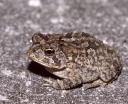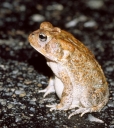Southern Toad (Anaxyrus terrestris)
Description: The southern toad is a medium-sized, plump species with a snout-to-vent length of up to 3.6 inches with females being slightly larger than males. The most obvious distinguishing feature is the knobs on the head and the backward-pointing spurs that extends as far as the paratoid glands. The dorsal surface is covered with warts, some of which may be spiny. The color of the head, back and sides varies from brick red to mottled grey, brown and black while the underparts are pale, sometimes with dark spots on the chest.
Habitat: The southern toad is nocturnal and lives in a burrow by day, or sometimes hides under a log or pile of debris. It occurs in woodland in cultivated land and gardens and sometimes stands beneath outdoor lights at night to pick up the attracted insects that fall to the ground. In winter it may become inactive and remain in its burrow for extended periods. Some do not appear to be threatened by humans whilst others are.
Range: The southern toad is found on the coastal plain of the southeastern United States. Its range extends from southern Virginia to Florida and Louisiana and there are two isolated populations on the Piedmont plateau and the Blue Ridge Mountains in South Carolina.
Diet: They will eat just about anything they can catch with their sticky tongue and swallow, including beetles, earwigs, ants, cockroaches, crickets, snails, bees, and lightning bugs.
Reproduction: Breeding starts in spring when the males migrate from their upland habitats to the lowland pools, ditches, swamps and the margins of lakes where they breed. The breeding season typically occurs between the first of March into late May although it will occasionally continue up until September. Heavy rain triggers large numbers of males to congregate and call, forming choruses. Each female lays a clutch of up to 4,000 eggs and the water may be thick with spawn. The eggs hatch and the tadpoles take 30 to 55 days to develop before undergoing metamorphosis into juvenile toads about 0.4 inches long. The tadpoles feed on algae which they scrape from underwater vegetation. Adults are carnivorous and feed on any small invertebrates they can find.
Status: The southern toad has a wide range and is common in much of that range, though it has become scarce in Florida in areas where the cane toad has become established. In general it is an adaptable species and faces no particular threats.
Subspecies: None
»» Kingdom: Animalia - Animals
»» Phylum: Chordata - Chordates
»» Subphylum: Vertebrata - Vertebrates
»» Class: Amphibia - Amphibians
»» Order: Anura - Frogs & Toads
»» Family: Bufonidae - Toads
»» Genus: Anaxyrus
»» Species: Anaxyrus terrestris - Southern Toad
»» Subspecies: None
This article uses material from the Wikipedia article "Southern Toad", which is released under the Creative Commons Attribution-Share-Alike License 3.0. Content may have been omitted from the original, but no content has been changed or extended.
|







